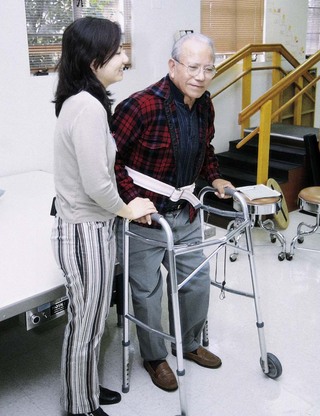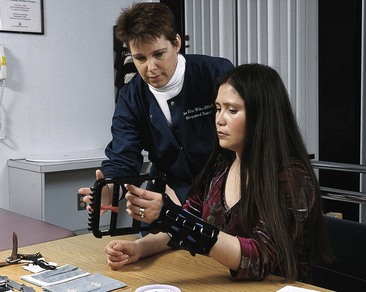Chapter 8 Rehabilitation Concepts for Chronic and Disabling Health Problems
Safe and Effective Care Environment
1. Identify the roles of each member of the interdisciplinary rehabilitation team.
2. Explain the importance of collaborating with members of the rehabilitation team when providing patient care.
3. Delegate and supervise selected nursing tasks as part of care for the rehabilitation patient.
4. Coordinate recommendations for home modifications with the patient, family, occupational therapist, and case manager.
5. Use safe patient handling practices based on current evidence to prevent self-injury.
Health Promotion and Maintenance
6. Develop a teaching plan to prevent complications for the rehabilitation patient who has impaired physical mobility.
7. Assess the patient’s response to chronic or disabling health problems.
8. Identify special considerations for older adults undergoing rehabilitative care.
9. Interpret health assessment findings to plan appropriate collaborative care for the rehabilitation patient.
10. Assess the ability of patients to use assistive/adaptive devices to promote functional ability.
11. Plan interventions to prevent skin breakdown for rehabilitation patients.
12. Differentiate retraining methods for a patient with a spastic versus flaccid bladder and bowel.
13. Explain the primary concerns for patients being discharged to home after rehabilitation.
http://evolve.elsevier.com/Iggy/
Answer Key for NCLEX Examination Challenges and Decision-Making Challenges
Review Questions for the NCLEX® Examination
Overview
The Rehabilitation Team
• Nurses and nursing assistants
• Physical therapists and assistants
• Occupational therapists and assistants
• Speech-language pathologists and assistants
• Rehabilitation assistants/restorative aides
• Recreational or activity therapists
• Cognitive therapists or neuropsychologists
Rehabilitation nurses in the inpatient setting coordinate the efforts of health care team members and therefore function as the patient’s case manager. Nurses also create a rehabilitation milieu, which includes (Pryor, 2010):
• Allowing time for patients to practice self-management skills
• Encouraging patients and providing emotional support
• Protecting patients from embarrassment (e.g., bowel training)
Table 8-1 summarizes the nurse’s role as part of the rehabilitation team. Because of an increase in the need for older adult rehabilitation, some nurses specialize in gerontologic rehabilitation (Association of Rehabilitation Nurses, 2008b). Nurses and other health care professionals may be designated as rehabilitation case managers in the home or in acute care settings. Case management is described in Chapter 1.
TABLE 8-1 NURSE’S ROLE IN THE REHABILITATION TEAM
Adapted from Association of Rehabilitation Nurses. (2008). Standards and scope of rehabilitation nursing practice, Glenview, IL: Author.
Physical therapists intervene to help the patient achieve self-management by focusing on gross mobility skills (e.g., by facilitating ambulation and teaching the patient to use a walker) (Fig. 8-1). They may also teach techniques for performing certain ADLs, such as transferring (e.g., moving into and out of bed), ambulating, and toileting, and can assist with cognitive retraining (often for patients with TBI). Physical therapy assistants (PTAs) may be employed to help the PT.
Occupational therapists work to develop the patient’s fine motor skills used for ADL self-management, such as those required for eating, hygiene, and dressing. OTs also teach patients how to perform independent living skills, such as cooking and shopping. Many inpatient rehabilitation facilities have fully furnished and equipped apartments where patients can practice independent living skills in a mock setting under supervision. To accomplish these outcomes, OTs teach skills related to coordination (e.g., hand movements) and cognitive retraining (Fig. 8-2). Occupational therapy assistants (OTAs) may be available to help the OT.
Patient-centered Collaborative Care
Assessment
Physical Assessment/Clinical Manifestations
Upon admission for baseline and every day thereafter according agency policy and type of setting, collect the physical assessment data systematically according to major body systems (Table 8-2). The focus of the assessment related to rehabilitation and chronic disease is on the functional abilities of the patient.
TABLE 8-2 ASSESSMENT OF PATIENTS IN REHABILITATION SETTINGS
| BODY SYSTEM | RELEVANT DATA |
|---|---|
| Cardiovascular system | |
| Respiratory system | |
| Gastrointestinal system and nutrition | |
| Renal-urinary system | |
| Neurologic system | |
| Musculoskeletal system | |
| Integumentary system |
Cardiovascular and Respiratory Assessment
A hindrance to rehabilitation for patients with cardiac disorders is fear, particularly for older adults. These patients may have survived a life-threatening experience (e.g., myocardial infarction) and may be so afraid of recurrence or death that they are unable or unwilling to resume any activity. They usually benefit from participation in a structured cardiac rehabilitation program. (See Chapter 40 for a complete description of cardiac rehabilitation.)
Gastrointestinal and Nutritional Assessment
Monitor the patient’s oral intake and pattern of eating. Also, assess for the presence of anorexia, dysphagia, nausea, vomiting, or discomfort that may interfere with oral intake. Determine whether the patient wears dentures and, if so, whether they fit. Review the patient’s height, weight, hemoglobin and hematocrit levels, serum prealbumin, and blood glucose levels (see Chapter 63 for discussion of how to perform a nutritional assessment). Weight loss or weight gain is particularly significant and may be related to an associated disease or to the illness that caused the disability.
Note any changes in the patient’s bowel routine or stool consistency. The most common problem for rehabilitation patients is constipation. In their classic best practice guidelines, the Association of Rehabilitation Nurses (2002) defines constipation as the passage of hard, dry stool less than 3 times a week or significant change in the patient’s usual habits for more than 3 months. Examples of important changes include abdominal fullness and bloating and straining when having a bowel movement.
Neurologic and Musculoskeletal Assessment
Assess the patient’s cognitive abilities, especially if there is a head injury or stroke. Several tools are available to evaluate cognition. One of the most common is the Mini-Mental State Examination, which is described in detail in Chapter 44.
Skin Assessment
Action Alert
Most rehabilitation settings use special skin assessment tools to identify patients at risk for skin breakdown. For example, the classic Braden Scale for Predicting Pressure Ulcer Risk (see Chapter 27) assesses several areas: sensory perception, skin moisture, activity level, nutritional status, and potential for friction and shear.
If a pressure ulcer or other change in skin integrity develops, accurately assess the problem and its possible causes. Inspect the skin every 2 hours until the patient learns to inspect his or her own skin several times a day. Measure the depth and diameter of any open skin areas in inches or centimeters, depending on the policy of the facility. Assess the area around the open lesion to determine the presence of cellulitis or other tissue damage. Chapter 27 includes several widely used classification systems for assessing skin breakdown. Determine the patient’s knowledge about the cause and treatment of skin breakdown, as well as his or her ability to inspect the skin and participate in maintaining skin integrity.
Physiological Integrity
A. Take her heart rate and blood pressure.
B. Stop her activity and provide a rest period.
C. Call her health care provider immediately.
Stay updated, free articles. Join our Telegram channel

Full access? Get Clinical Tree




